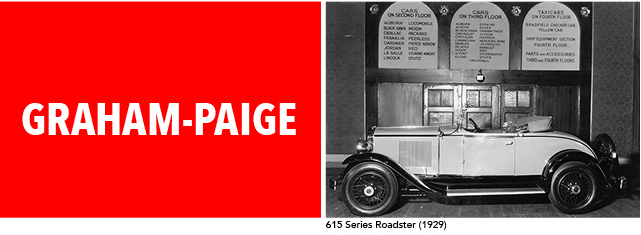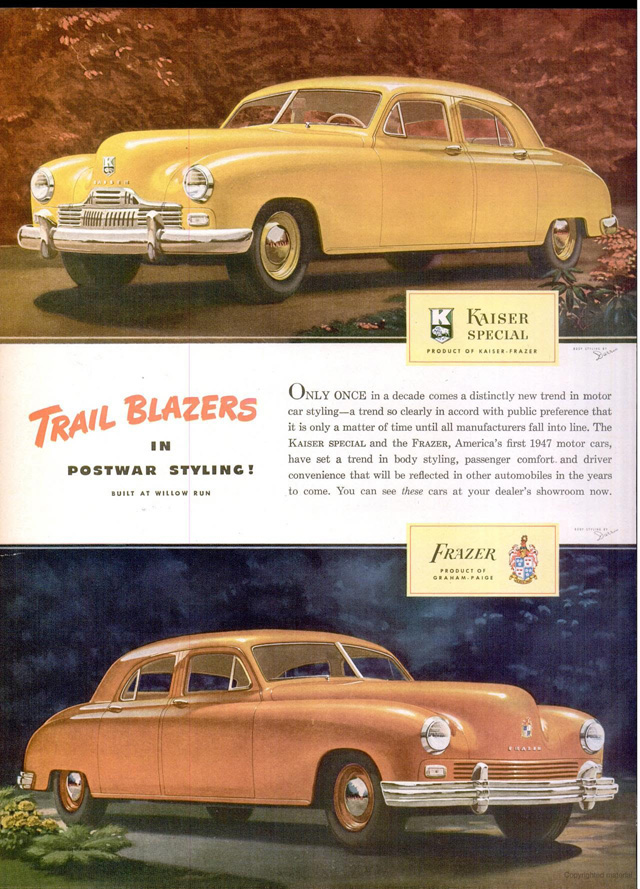
After their selling their interest in an Indiana glass operation to the Owens Bottle Company of Toledo in 1919, brothers Joseph B. Robert C., and Ray A. Graham began to manufacturing truck bodies on passenger car chassis. By 1921, their trucks were sold through the Dodge dealer network and featured only Dodge engines and drivetrains. After moving to Detroit, their trucks were produced near Hamtramck, first at a Meldrum Avenue plant, then at facilities on Conant Avenue, and still later at a plant on Lynch Road. By 1926, they were the largest company in the world dedicated solely to truck production.
The Grahams were well positioned in the reorganized company after Dodge heirs sold their interests in 1925 to the Dillon, Read investment firm. Despite that, they broke from the company, and their holding company’s substantial interest in Libbey-Owens Sheet Glass in Toledo allowed Ray to forge the merger that created Libby-Owens-Ford in 1930. Even so, the Grahams were not prepared to leave auto manufacturing. They acquired the Paige-Detroit Motor Car Company in 1927 for $4 million and invested another $4 million in improvements. Established in 1909 with a plant on Fort Street, just west of Clark Street, it was later acquired by Harry Jewett and his family. Paige-Detroit found the sale to the Grahams opportune, as it was experiencing declining sales just as it was completing its new Warren Avenue facility on the Dearborn-Detroit border. The Grahams launched their own model design the following year and sold 73,000 of the cars. Graham-Paige, as it became known, quickly earned a reputation for quality and for its innovative designs, such as the 1930 model’s non-shattering glass and the 1932 Blue Streak Eight’s eight-cylinder engine, one-piece windshield, and stronger frame stabilized by a rear axle.
 Graham 8 Blue Streak Billboard (1930s)
Graham 8 Blue Streak Billboard (1930s)
Graham-Paige’s initial success was cut short by the Great Depression. Company President Joe Graham spent half a million dollars of his own money to keep the corporation afloat. In 1935, a number of struggling automobile companies, including Auburn, Pierce-Arrow, REO, and Hupp, discussed merging with Graham-Paige.
When such a merger failed to be consummated, Hupp proposed a different solution: Graham-Paige’s Warren Avenue plant could build both Hupp’s Skylark and Graham’s Hollywood vehicles. Hupp had acquired discontinued dies for the attractive Cord Beverly Sedan, but did not have the capacity to produce the car. Sharing the dies, each company could convert their chassis to rear wheel drive and each use their own engines. Graham-Paige would develop new dies to accommodate a differential for the rear wheel drive. After months of preparation, the plant started up in April 1940 and in mid-July production changed over to the next year’s model. But that point, Hupp withdrew from the joint operation and his company went into receivership a few months later.
In August 1940, Graham-Paige suspended auto production to concentrate on the war effort. With 3,500 workers on three shifts, the plant began producing amphibious tanks. The following spring, the Graham-Paige Corporation reported its first profit since 1933. President Graham concluded that the capital requirements for an auto factory were so great that the corporation should permanently retire from manufacturing complete automobiles. He then retired and was succeeded by Robert J. Hodgson, the former manager of the Detroit office of the Reconstruction Finance Corporation
Things did not go well for Hodgson. Labor problems during the war resulted in a shutdown of the Graham-Paige plant. Chrysler leased the plant for a time to produce aircraft components for the B-26 and B-29 Superfortress, which had a nose so large that trenches had to be dug in the floor and some of the bracing for the plant’s roof girders removed to accommodate the aircraft.

Immediately following the war, Graham-Paige collaborated with Kaiser-Frazer to produce a low-cost car, the Kaiser, at its Dearborn facility. But by 1946, Graham-Paige had lost seven million dollars and the company announced its exit from the industry. Kaiser-Frazer acquired Graham-Paige’s automotive assets and continued to use the company’s name until 1962. Several Graham-Paige innovations were copied by other manufacturers.
In 1947, Chrysler purchased the Warren Avenue plant, where it went on to build DeSoto bodies and engines. Discontinuing that line in 1959, the corporation retooled the plant to assemble the Chrysler Imperial, and still later used it for small parts production and, later, as a hub for its export operations.
Click the link below for more information from the Graham Owner’s Club International website:
The Graham Brothers and Their Car, a profile by Jeffrey I. Godshall that originally appeared in Automobile Quarterly and is posted at the Graham Owners Club International website.
TEXT & RESEARCH – DIANNE FEELEY & RON ALPERN
PHOTO CREDITS
Detroit Historical Society
Graham-Paige Roadster / Graham 8 Blue Streak Billboard (1930s)



